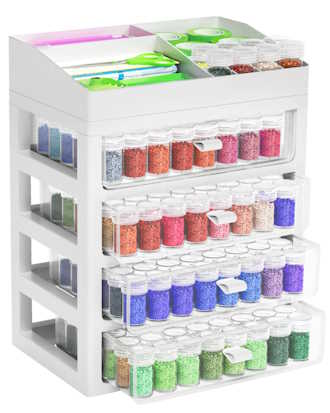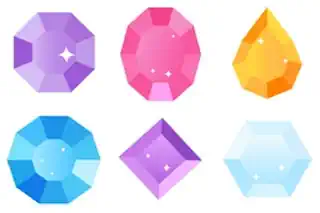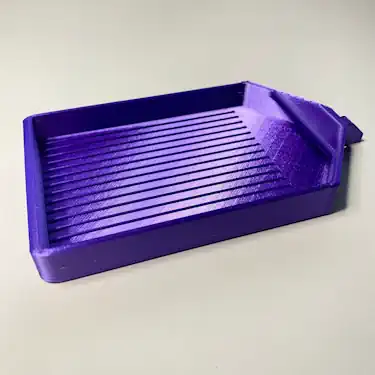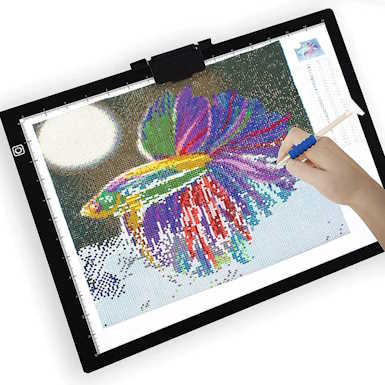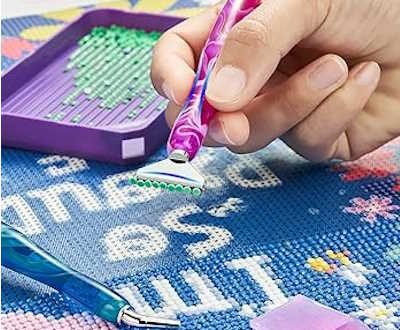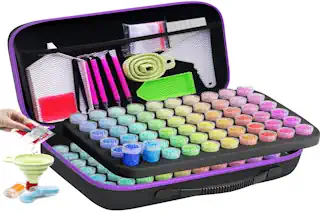A Kaleidoscope of Creativity: The Unseen World of Diamond Art Gems
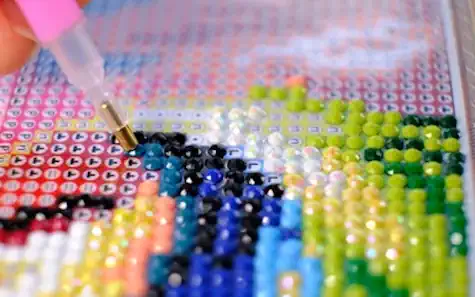
The art of diamond painting has transformed the world of visual expression, blending crafting with an almost meditative experience of creating beautiful, iridescent masterpieces. At the heart of this innovative craft are tiny, shimmering jewels known as diamond art gems. These petite pieces are the building blocks of diamond art, and yet, they come in a variety as vast as the spectrum itself. For those with an affinity for all things art and craft, understanding the breadth of options available in diamond painting beads and other art gems can open doors to personal creativity, redefine an aesthetic, or simply add that perfect finishing touch to any project. Today, we’ll take a magnifying glass to this world of gems, unraveling the different types available and exploring how they can be harnessed to augment your artistic visions.
Exploring the Sheen of Round and Square Gems
The most foundational distinction among diamond art gems is their shape. Round and square gems are the archetypes of the diamond painting art world, each possessing unique attributes that influence the final look and feel of a piece.
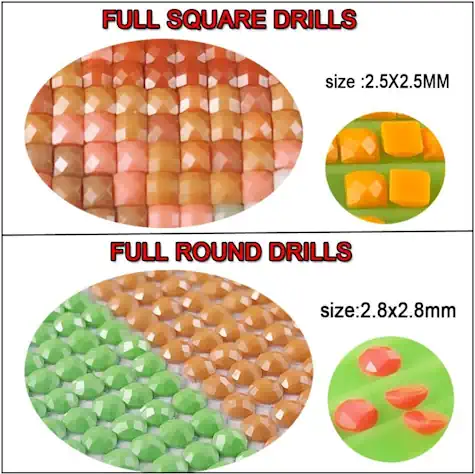
The Classic Elegance of Round Gems
Round diamonds are the quintessential diamond art gem, with a charm that stems from their smooth, symmetrical form. The circular nature of these gems allows for a more streamlined approach to placement, ensuring that the resulting image exudes a gentle, flowing energy. Crafters often find that round gems require slightly less precision than their square counterparts, making them a popular choice for beginners. Their distinct curved edges also provide a seamless finish, making them ideal for designs that feature organic shapes or intricate patterns where a softer aesthetic is desired.
The Mosaic Precision of Square Gems
Square diamonds, with their crisp edges and perfectly straight sides, bring a geometric precision to diamond paintings that create a mosaic-like effect. When placed side by side, square gems leave minimal space, resulting in a piece with reduced visible canvas. This can lead to a crisper, more defined image, which is particularly advantageous for designs with straight lines, angular shapes, or text. Skilled crafters often favor square gems for their ability to capture the fine details of a complex pattern, bestowing upon the artwork an almost photographic quality that’s hard to achieve with other gem types.
Special Effects Gems: Illuminating the Darkness
Beyond the standard offerings of round and square gems, the diamond art world boasts a treasure trove of special effects gems. These unique variations add an extra dimension to your creations, whether they’re glowing gently in the night or catching the sunlight in a prismatic dance.
Glow-in-the-Dark Gems: A Twinkling Surprise
For those enchanted by the magic of phosphorescence, glow-in-the-dark diamond gems are the perfect addition to their palette. With the ability to emit a soft, ethereal glow after being charged by light, these gems provide an unexpected enchantment to artwork. Crafters can strategically place these gems to create twinkling stars in a night sky, illuminate windows of a cityscape, or add highlights to a nocturnal animal portrait. The imaginative possibilities are as endless as the starry sky itself, adding an element of surprise that stirs wonder long after the lights are out.
Transparent Gems: A Delicate Kaleidoscope
Transparent diamond art gems offer a subtler effect, allowing light to pass through their facets to create a delicate interplay of colors and shadows. When set against a rich backdrop of deep colors, these gems can give the illusion of stained glass, bringing an air of solemn beauty to religious iconography or a regal touch to crown jewels. They work wonderfully in pieces where light and translucence are thematic, such as in depictions of water, glass, or even in abstract art where the focus in on the interaction of light and form.
Getting Down to Size and Quality
In the realm of diamond art, size does matter – but it isn’t the only metric to consider. The quality of the gems plays a significant role in the price, overall appeal and longevity of the finished project.
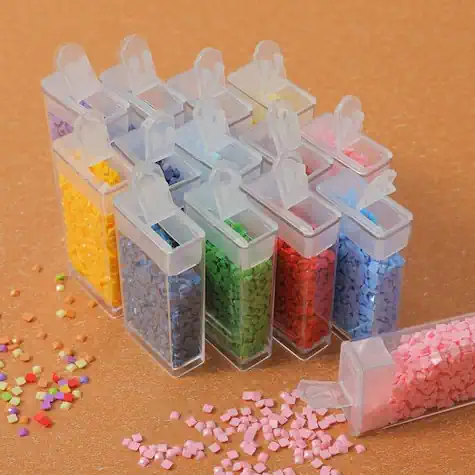
The Spectrum of Sizes and Facets in Diamond Art Gems
In the world of diamond painting, the variation in sizes and facets of diamond art gems significantly affects the granular detail and overall sparkling effect of the artwork. Here’s a concise guide to understanding the common options available:
2.5mm Gems (“10×10”): These small gems are perfect for projects that require high levels of detail, as their 100 facets capture light from various angles, creating a dazzling effect.
2.8mm Gems (“13×13”): A slightly larger option, these gems offer a good balance between coverage and detail, ideal for medium-sized projects.
3.0mm Gems (“16×16”): With more facets (256 in total), these gems enhance the sparkle and are suitable for projects where a bit more coverage is needed without sacrificing too much on the detail.
3.8mm Gems (“20×20”): For those looking for gems that cover larger areas more quickly but still maintain a considerable amount of detail, the 400 facets of these gems make them a popular choice.
4.0mm Gems (“24×24”): These are among the largest commonly used gems in diamond painting, offering rapid coverage and a unique look due to their 576 facets, though they are best suited for larger canvases where detail is not the primary concern.
Each size and facet option offers a unique approach to creating diamond art, allowing artists to tailor their projects to meet specific artistic visions and finishes.
Quality: The Essence of Every Stroke
Quality in diamond art gems is determined by factors such as the material used, the precision of the cutting, and the application of the adhesive. High-quality gems are cut with pristine angles, promoting a consistent and brilliant shine. They are also more likely to stay in place once applied, ensuring that your artwork remains intact and resplendent. Inferior gems can dull a project’s quality, quite literally, by losing their sparkle over time or becoming dislodged and lost, leaving an incomplete and less impressive work.
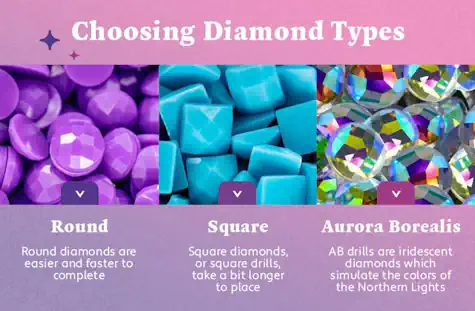
Diverse Cuts of Diamond Art Gems
The artistry of diamond painting extends to the variety of cuts applied to the gems, each reflects light with a unique aesthetic and interplay of light. Here’s a glance at the different cuts used:
Round Cut: The most popular choice for diamond painting, characterized by its circular shape and numerous facets, ideal for creating a dazzling, reflective surface.
Square Cut: Offers a sharp, defined edge that fits snugly against other gems, reducing gaps and enhancing the mosaic effect with a crisp finish.
Baguette Cut: A longer, rectangular shape that adds an element of sophistication and elongation, perfect for specific details or creating a unique texture within the artwork.
Marquise Cut: Features an elongated, boat-shaped design that brings a touch of elegance and distinctive flair, useful in floral designs or as unique accents.
Heart Cut: A charming choice that adds a romantic element to any piece, with its lovely shape and sparkling facets reflecting light beautifully.
Tear Drop/Pear Cut: Combines the qualities of both round and marquise cuts, with one rounded end tapering to a point, ideal for depicting raindrops, petals, or adding a dynamic dimension.
Trillion Cut: A triangular shape with sharp edges, offering a modern and striking appearance that stands out, especially when used as a focal point or in geometric designs.
Round Drills Cut: This innovative cut introduces a cylindrical shape that brings a new dimension to diamond art. Its uniform, three-dimensional appearance offers a tactile texture to the artwork, making it ideal for simulating objects with a cylindrical form, such as poles, trees, or architectural elements. The drill cut’s unique structure allows it to catch and distribute light evenly, providing a consistent gleam from all angles and adding depth to any piece it adorns.
Each cut serves a specific purpose in the craft of diamond painting, enabling artists to explore a myriad of textures and light dynamics for the overall appearance of their creations.
Choosing Your Gem: A Personal and Practical Process
When it comes to selecting diamond art gems for a project, one must consider a host of variables ranging from the practical to the personal. The decision is an art form in itself, blending one’s technical understanding with the subjective aesthetic taste.
Assessing the Design’s Needs
The first step in choosing the right diamond art gem is to assess the design you’re working on. Is it intricate or minimalist? Do the shapes within it lean towards curves or straight lines? Different designs will call for different gem types to be used in different volumes, so it’s essential to align your gem selection with the project’s inherent requirements.
Surveying Your Sensibilities
It’s also vital to factor in your personal preferences. Are you driven by a pull towards precise geometry, or is your artistic spirit more attuned to the gentle curves of nature? The gems you choose will ultimately reflect your artistic identity – so listen to your heart as much as your head when making your selection.
Budgeting Your Brilliance
While art is often a labor of love, budget constraints can also be part of the diamond painting reality. Keep in mind that the cost of the gems can vary, not just based on the type and effect but also on the overall quantity required for your project. Staying within budget need not compromise the brilliance of your work, but it does necessitate a degree of strategic gem selection.
The Practice of Placing Gems
Applying diamond art gems is an intricate process that requires patience and precision. Each type of gem may require a slightly different technique to ensure they’re placed correctly and securely.
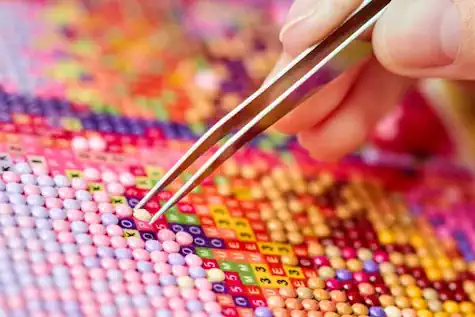
Round Gems: A Methodical Approach
When working with round gems, start from the center of a section and work your way outwards. This method ensures that the gems are aligned and that there’s a balanced distribution of colors and shapes. The slight overlapping that naturally occurs with round gems adds depth to the final piece, creating a three-dimensional effect that’s uniform and pleasing to the eye.
Square Gems: A Mosaic of Details
The placement of square gems is akin to assembling a jigsaw puzzle, each piece meticulously placed to reveal the larger picture. Begin by finding a corner or an edge and then fill inwards, section by section. The challenge with square gems lies in their unforgiving nature; misaligned squares will be more apparent. However, when done with care, the results are an impressive display of detail and precision.
Special Effects Gems: A Strategic Sparkle
Special effects gems should be used sparingly but strategically. Because they stand out, they can quickly become the focal point of your work. Place them with intention, whether it’s to highlight certain aspects of the design or to create a nuanced effect that underlines the narrative of the piece.
Showcasing Diamond Art at its Best
The true magic of diamond painting is in the transformation – watching as a blank canvas is filled with the luster and warmth of a thousand gems. To truly appreciate the art, it’s inspiring to see the range of projects that gem types can enhance and the diverse styles and themes they can complement.
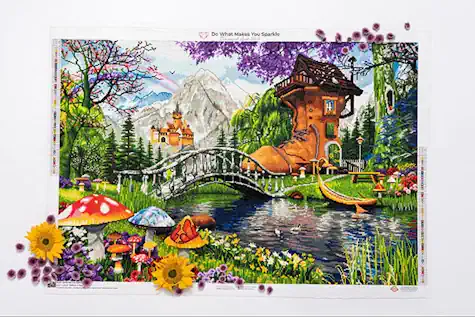
From Classic to Contemporary
Whether it’s a classical portrait, a contemporary landscape, or a whimsical animal, diamond art gems can adapt to any style. The choice of gem type can accentuate the essence of the artwork, from adding a touch of surrealism to a modern piece to amplifying the regality of a historical one with the right combination of gems and placement.
The Intricate and the Extravagant
Some diamond art projects are all about the details, with complex patterns and a myriad of colors. Others are large-scale and lavish, with a single color or a limited palette creating a grand, imposing effect. No matter the level of intricacy or the size, the use of varied gems enriches the texture and depth of these pieces, making them truly captivating.
Sourcing Your Sparkle: Where to Find Diverse Gem Types
Now that you’re sold on the idea of experimenting with different diamond art gems, the next logical step is to find where to get them. Fortunately, the market for diamonds is rich with options, both online and offline, that cater to the specific needs of your project.
Online Outlets: A World of Convenience
E-commerce has revolutionized the way we shop for craft supplies, and diamond art gems are no exception. Websites dedicated to diamond painting offer a vast range of gem types at the click of a button, allowing for convenience and the comfort of choice. Look for retailers with positive reviews and a brand with a reputation for high-quality products to ensure satisfaction with your purchase.
Brick-and-Mortar Stores: A Touchpoint with Quality
While the convenience of online shopping is undeniable, there’s something to be said for the tactile experience of examining gems in person. Local craft stores often carry a selection of diamond art gems, giving you the opportunity to gauge their quality and select the perfect hues for your project. Engaging with a the store with knowledgeable staff can also provide insight into the world of diamond art and guide your purchase.
Conclusion: A Gem for Every Artist
The world of diamond art is as diverse as the art forms it intersects with. Within it, the gems that breathe life into this medium are as varied as the imaginations that conceive of the projects where they’ll be used. Just as each gem brings its own story and luster to a piece, each artist brings their unique perspective, taste, and technique to the craft. Whether you’re a seasoned diamond painter or about to take your first careful strokes, consider the treasure trove of gems at your disposal – they have the power to elevate your art in ways you might never have imagined.
Diamond art gems are not just the accessories, they are the co-creators — the silent partners in your creative endeavor. They offer an opportunity to infuse personality and character into your art, to surprise and delight with their special effects, to add complexity or keep things elegantly simple. The right gem can draw the eye, invoke a feeling, or tell a story all on its own. And together, in clusters and patterns designated by your vision, they can turn an ordinary canvas into a radiant tapestry ready to share with the world.
Now, with a comprehensive view of the different types of diamond art gems and their profound impact on your projects, it’s time for you to pick up your pen – or rather, your gem applicator – and add a new chapter to your diamond painting story. The choices are endless, and so are the potentials they unlock for your diamond art beads. Happy painting!
Frequently Asked Questions (FAQ)
What is diamond art?
Diamond art is a form of creative craft similar to cross-stitch and paint-by-numbers. It involves placing tiny, shiny resin gems on a canvas that has a sticky surface and a pre-printed design, creating a sparkling piece of artwork as a result.
How do I choose the right gems for my diamond painting kits?
Selecting the right gems depends on the effect you wish to achieve in your artwork. Consider the theme, color scheme, and level of detail in your design. Round gems are versatile and offer a soft look with slight overlapping, square gems fit snugly for a more detailed mosaic effect, and special effects gems add unique highlights or focal points. If looking to buy a kit be sure to discover what type of gem is included in the kit.
Can I mix different types of gems in one project?
Yes, mixing different types of gems can add texture and depth to your artwork. For example, combining round and square gems can highlight certain areas and make them stand out, while special effects gems can be used to draw attention to specific features of the design.
Where can I purchase diamond art gems?
Resin and acrylic art gems can be purchased online from specialized e-commerce sites dedicated to crafts and diamond painting or from brick-and-mortar craft stores. When purchasing, look for suppliers with good reviews to ensure the quality of the gems.
How do I start my diamond painting kit?
Begin by planning your design and selecting your gems. Prepare your workspace with a clean, flat surface. Start applying the gems to the canvas from one corner or the center, depending on the gem type and your project design. Use the gem applicator tool provided with most kits, and follow the color codes to match the patterns indicated on the canvas.
Can diamond art be considered a therapeutic activity?
Yes, many people find diamond painting to be a relaxing and therapeutic activity. The repetitive motion of placing gems and the focus required can help reduce stress, improve concentration, and provide a sense of accomplishment upon completing an artwork.
Is diamond art suitable for beginners?
Absolutely. Diamond art is accessible to crafters of all skill levels, including beginners. Many kits come with easy-to-follow instructions and everything needed to complete a project. Starting with simpler designs can help beginners get comfortable with the technique before moving on to more complex projects. Once you have a completed diamond painting be sure to put it on display and watch it glow.
